|
|
THE OAKS
Northern Red Oak, Northern Pin Oak,
Bur Oak, White Oak, and American
Beech
Fagaceae, The Beech Family
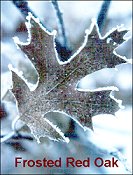 The
beech family has many tree and shrub species, with 6 genera and about 600 species that occur
world-wide with concentrations in the northern
temperate zone. Five genera and roughly 90 species occur in North
America. Although most members are oaks, the family is named after beech because
early plant classification was done by Europeans, where the European beech is a common
tree. The oak genus (Quercus) has two subgroups, the red oaks and
the white oaks. The red oak group is characterized by sharply pointed leaf lobes with bristles. The white oak
group has rounded lobes without bristles. ACORNS are readily recognized fruits of
the oaks. Acorns of red oaks take two years to mature. White oak acorns mature in
one year. All members, except beech, have male FLOWERS arranged in catkins that bloom in the spring. In the
U.P. the only common species are beech and red oak. We are on the northern fringe of the
historical oak range.
The
beech family has many tree and shrub species, with 6 genera and about 600 species that occur
world-wide with concentrations in the northern
temperate zone. Five genera and roughly 90 species occur in North
America. Although most members are oaks, the family is named after beech because
early plant classification was done by Europeans, where the European beech is a common
tree. The oak genus (Quercus) has two subgroups, the red oaks and
the white oaks. The red oak group is characterized by sharply pointed leaf lobes with bristles. The white oak
group has rounded lobes without bristles. ACORNS are readily recognized fruits of
the oaks. Acorns of red oaks take two years to mature. White oak acorns mature in
one year. All members, except beech, have male FLOWERS arranged in catkins that bloom in the spring. In the
U.P. the only common species are beech and red oak. We are on the northern fringe of the
historical oak range.
 AMERICAN BEECH
(Fagus grandifolia)
AMERICAN BEECH
(Fagus grandifolia)
Other Names: White Beech, Gray Beech, Red Beech, Ridge Beech
Key ID Features: Leaves, Buds, Bark, Fruit
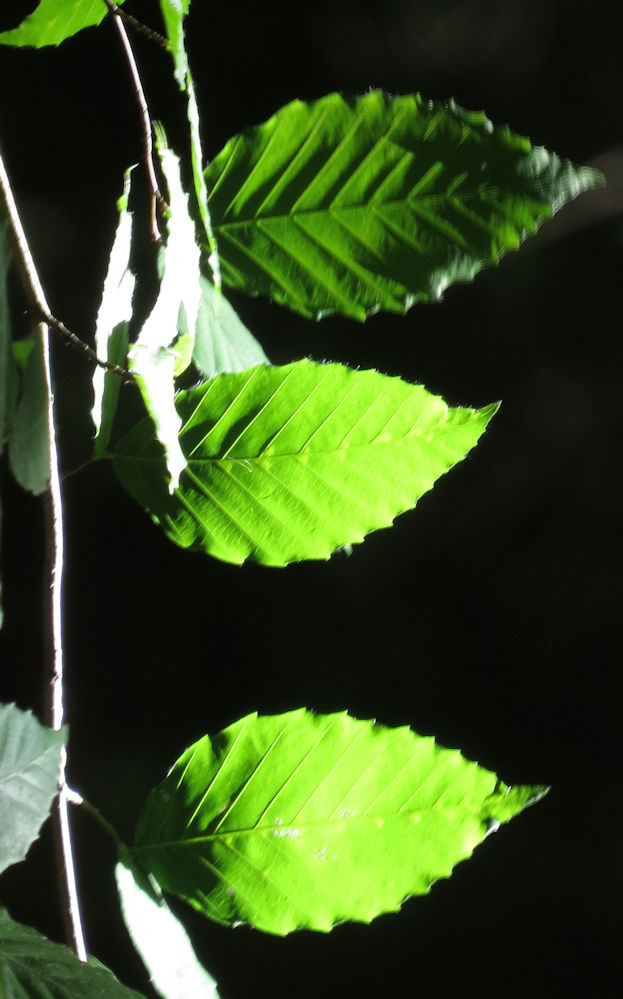
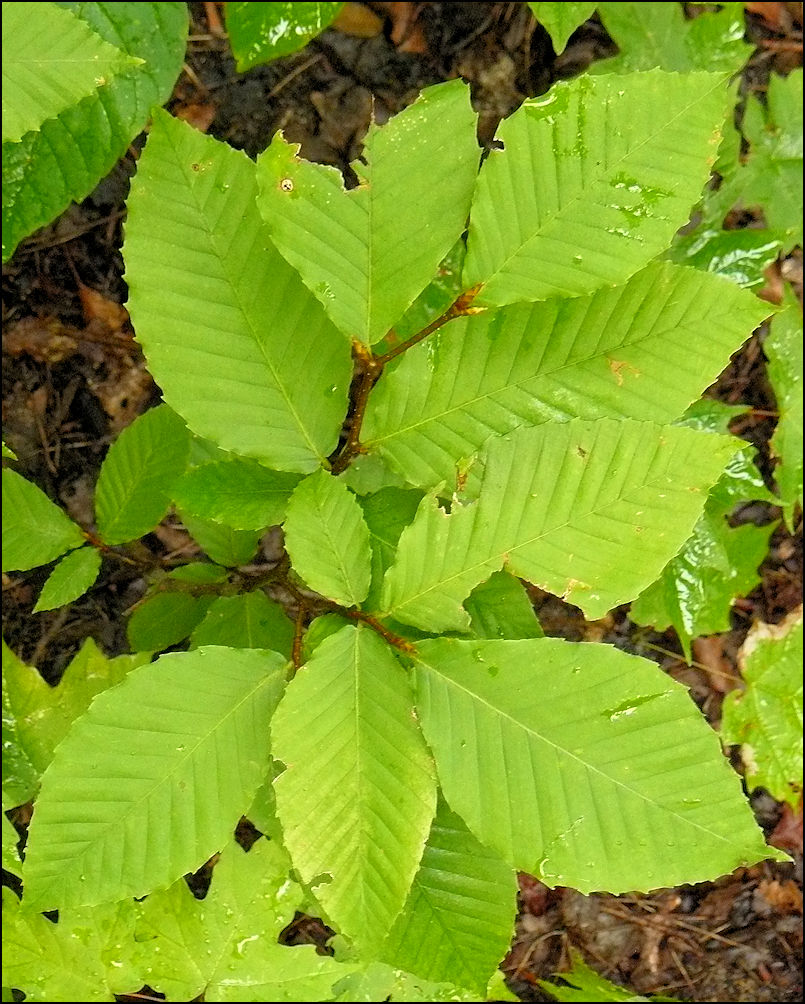
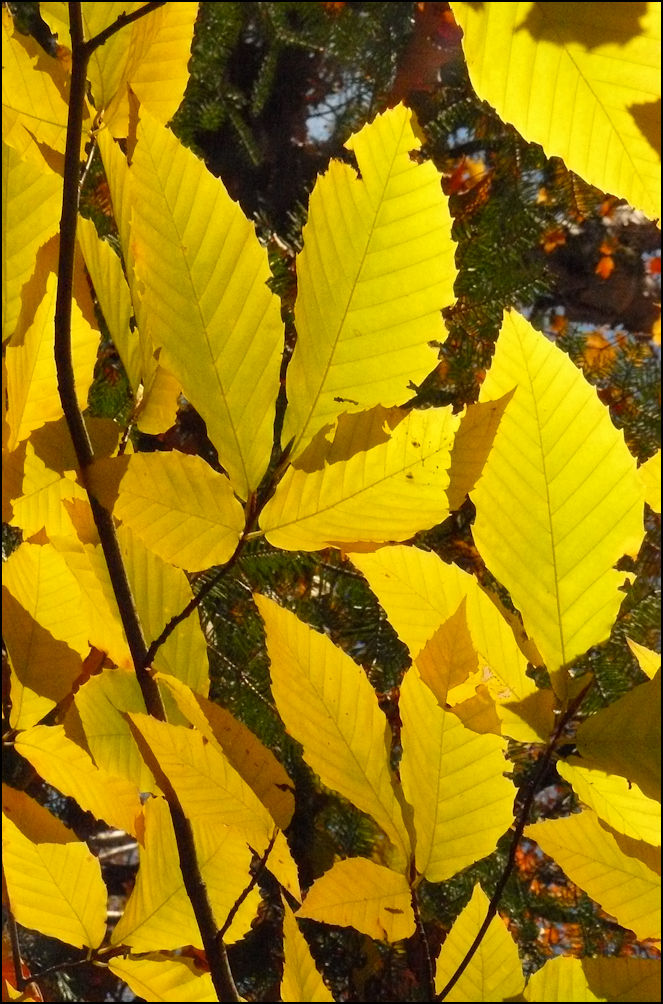
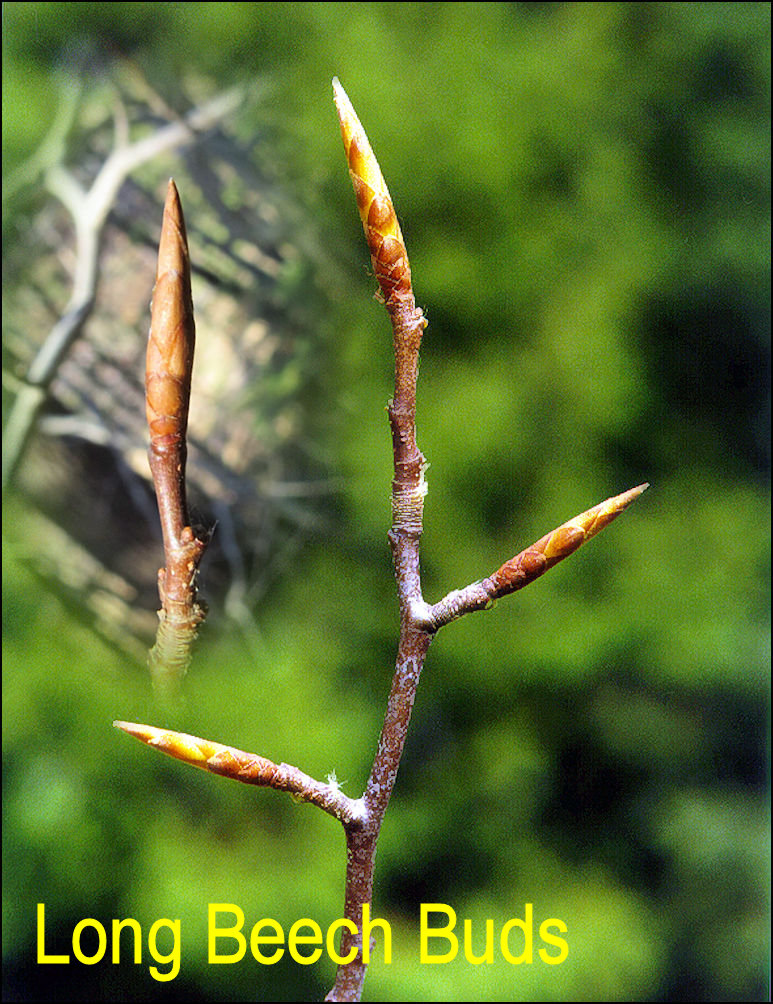
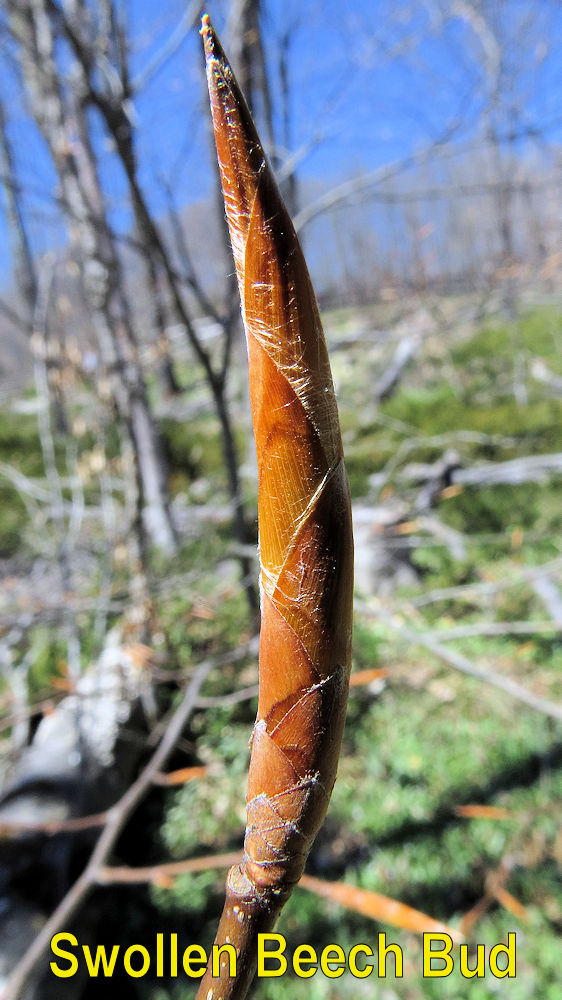
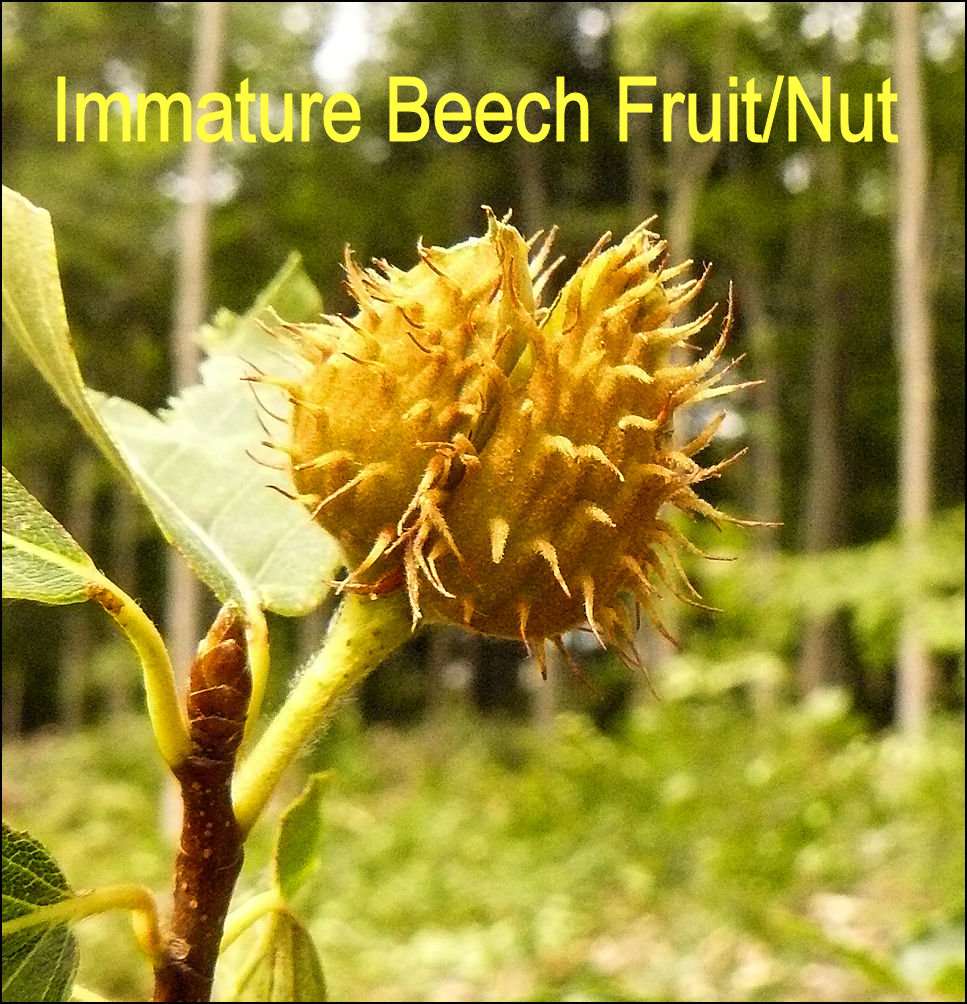
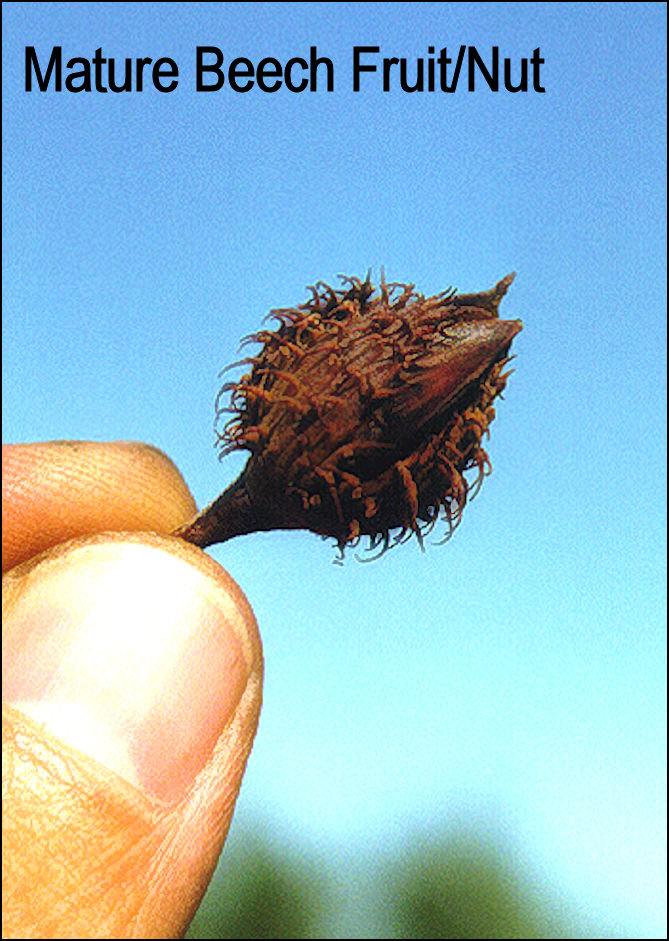
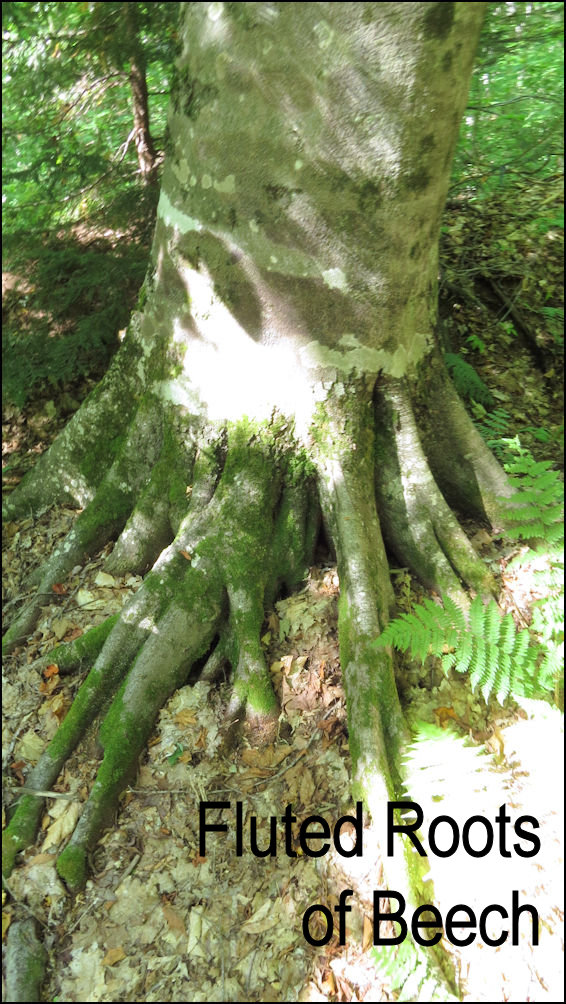
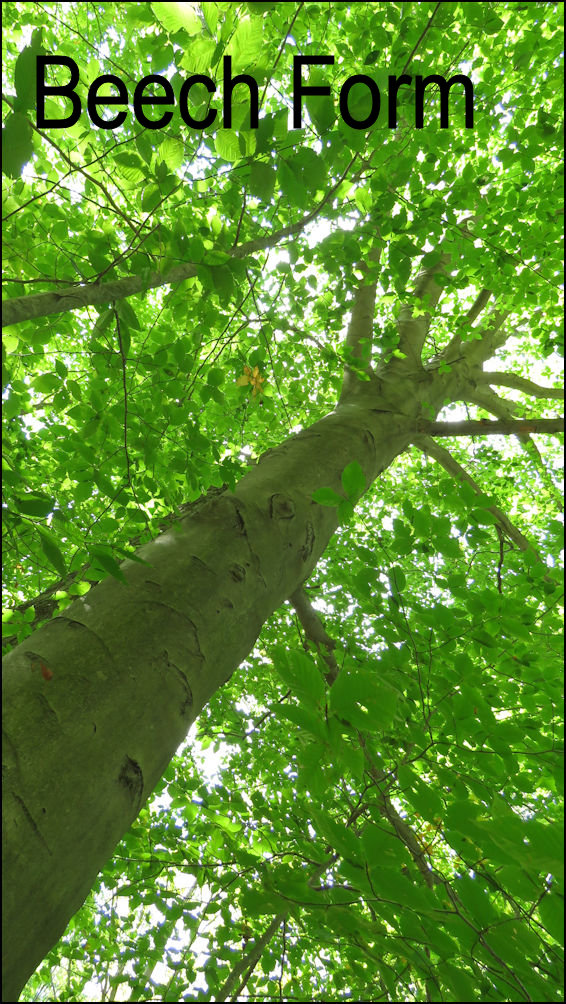
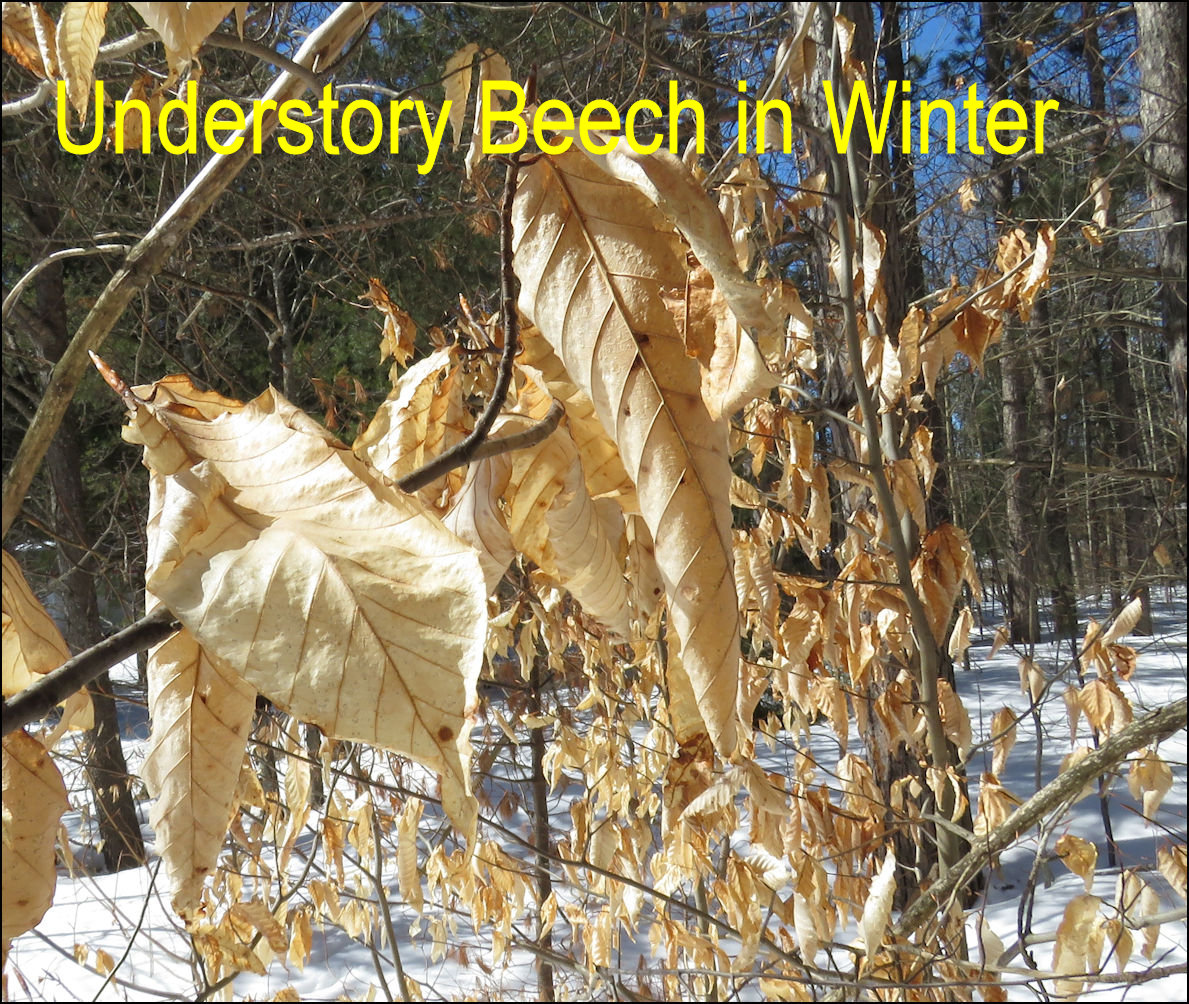
Beech LEAVES are 3-4 inches long
with many "points" or coarse
teeth along the margin.
Lateral leaf veins are
nearly parallel with each other. There are not any other U.P. trees with leaves
similar to beech. Separate male and female FLOWER clusters form in the spring.
BEECH-NUTS are about a half inch in size, housed in a spiny husk that splits into four
parts. The triangular nuts ripen in the fall and are an excellent food source for
many species of wildlife, such as deer and turkey. TWIGS are brown and slender.
The terminal BUDS of beech are
about an inch long, shaped sort of like little cigars. The BARK is smooth and gray,
even in large diameter trees. Tree SIZES can usually reach 60-80 feet in height and 2-3
feet in diameter. Beech is a common ASSOCIATE of our northern hardwood forest type, but only in the eastern
U.P. Oddly enough, beech does not commonly occur in the western counties.
Beech is very tolerant of shade and, as a result, is common in the understory of many
forest stands. During winter months, these understory beech often retain many of
their pale brown leaves. Ironwood is another understory species that will often
retain leaves into the winter. However, ironwood leaves are a darker brown. Common Pests: cankerworms, beech bark disease.
 NORTHERN RED
OAK (Quercus rubra)
NORTHERN RED
OAK (Quercus rubra)
Other Names: Red Oak, Gray Oak, Eastern Red Oak, Mountain Red Oak
Key ID Features: Leaves, Buds, Acorns, Stiff Twigs
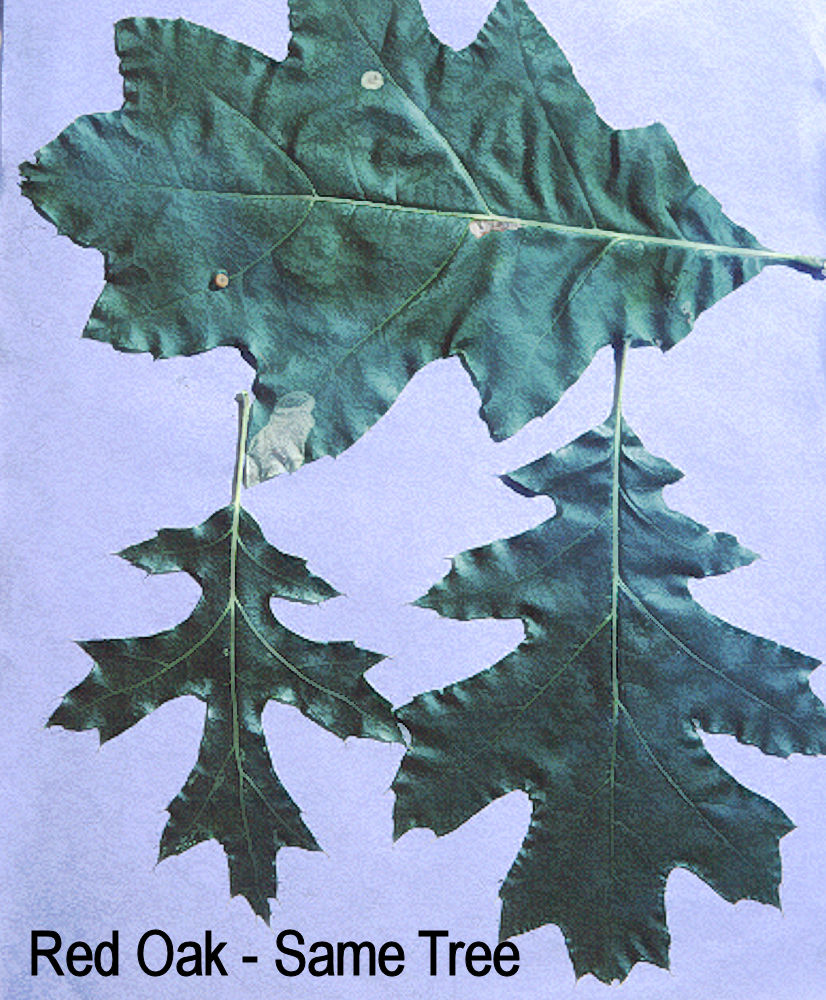
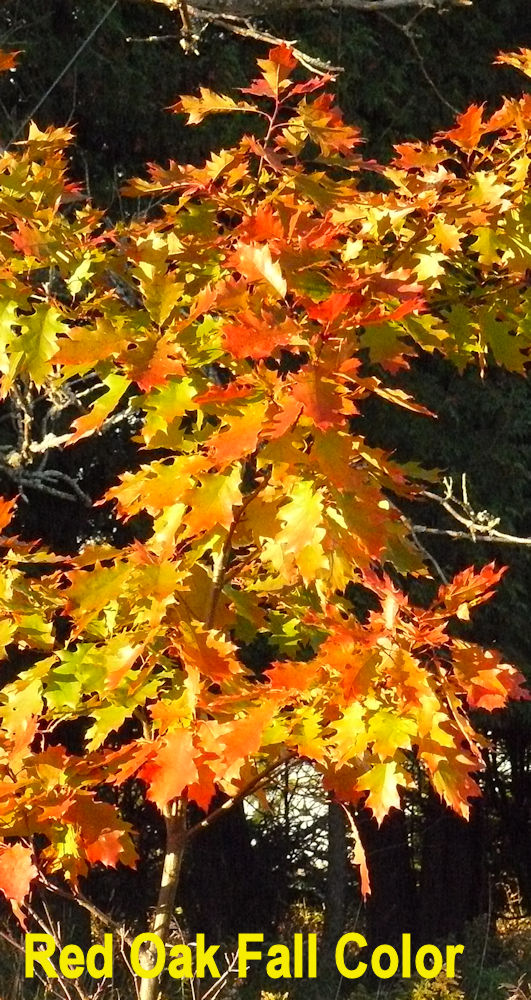
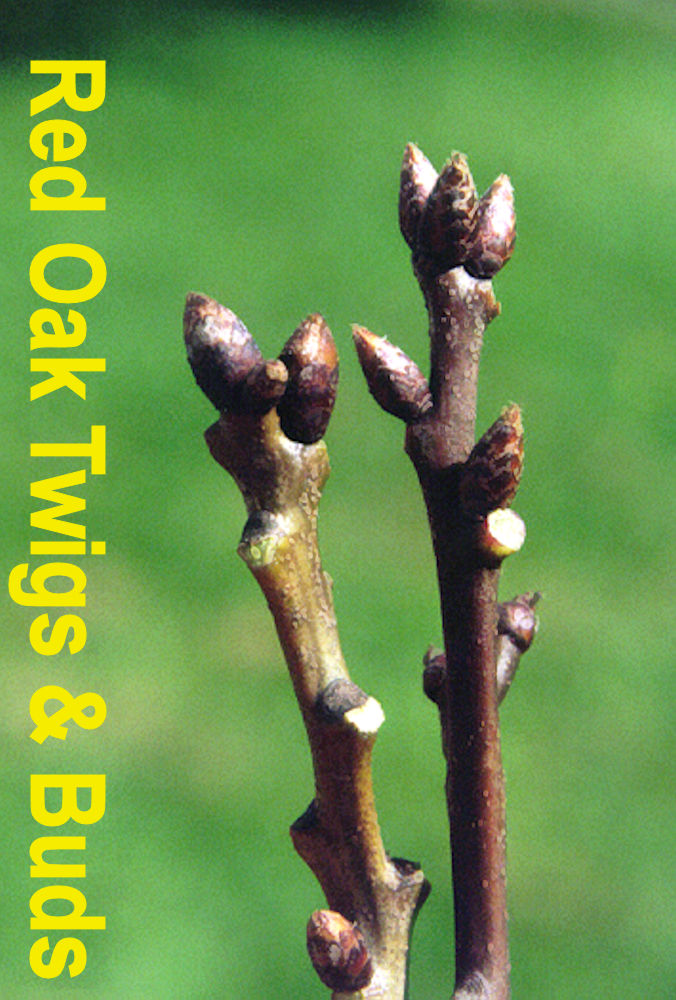
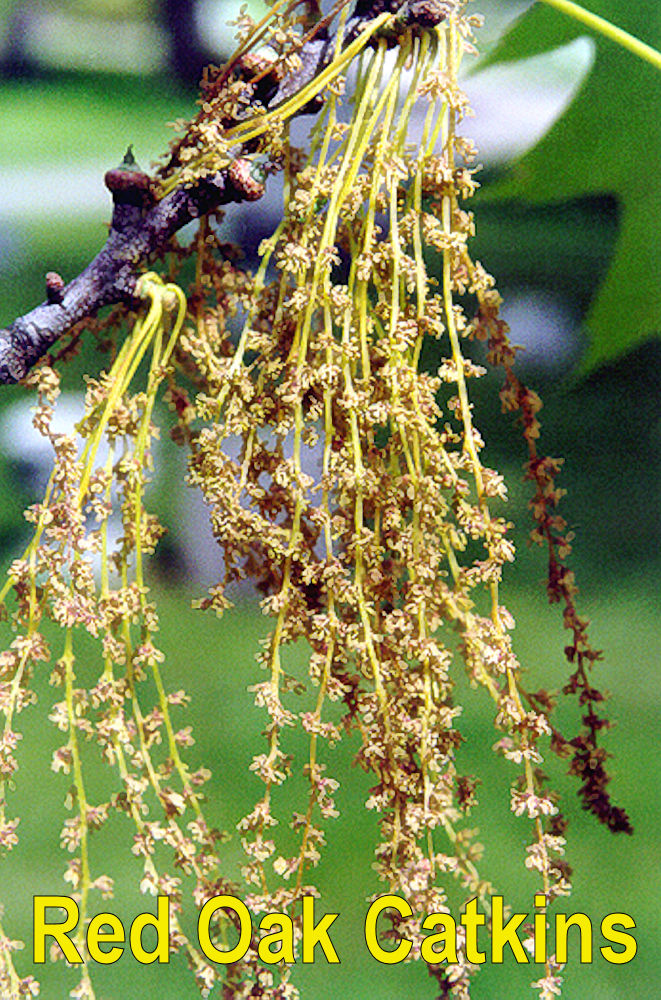
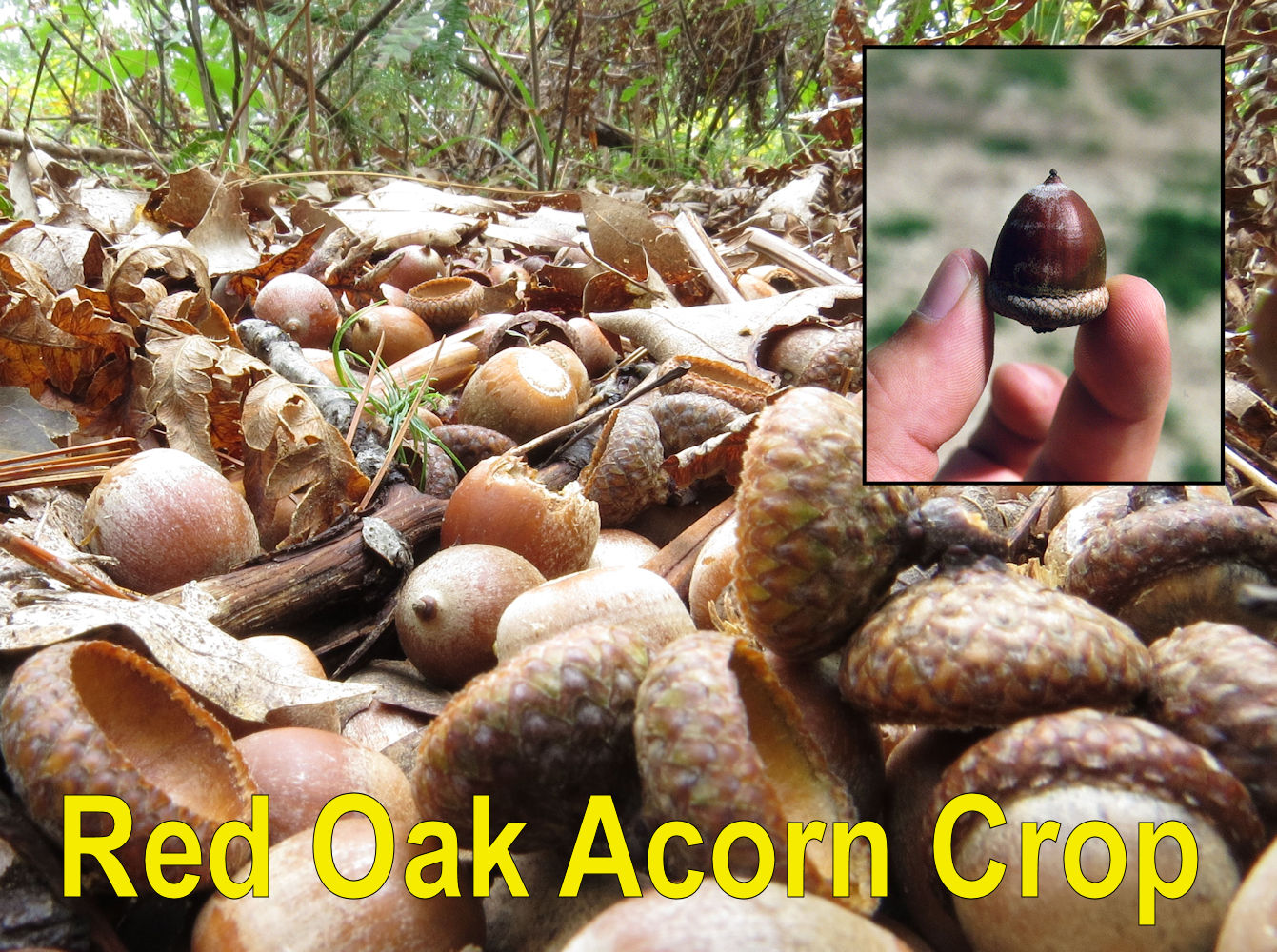
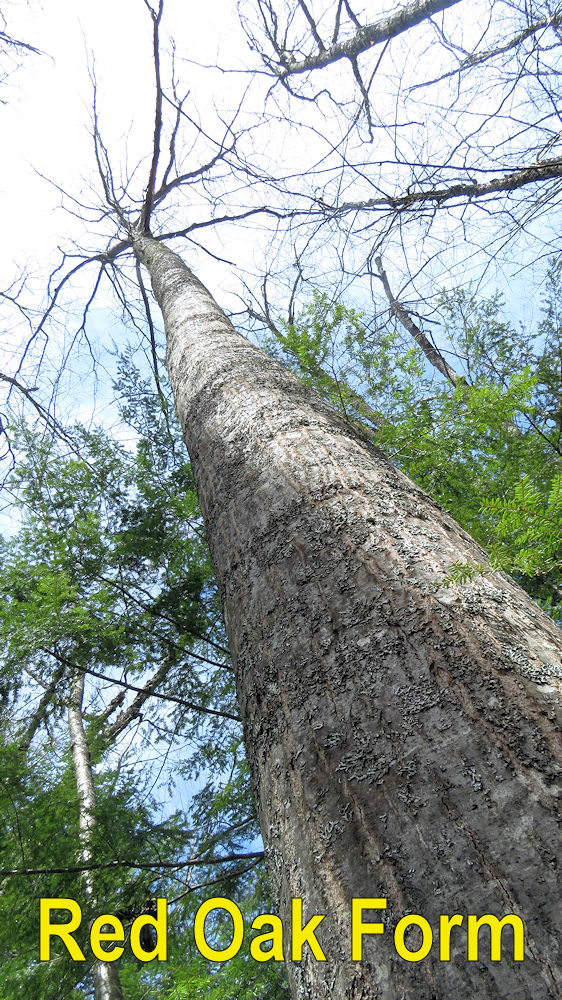
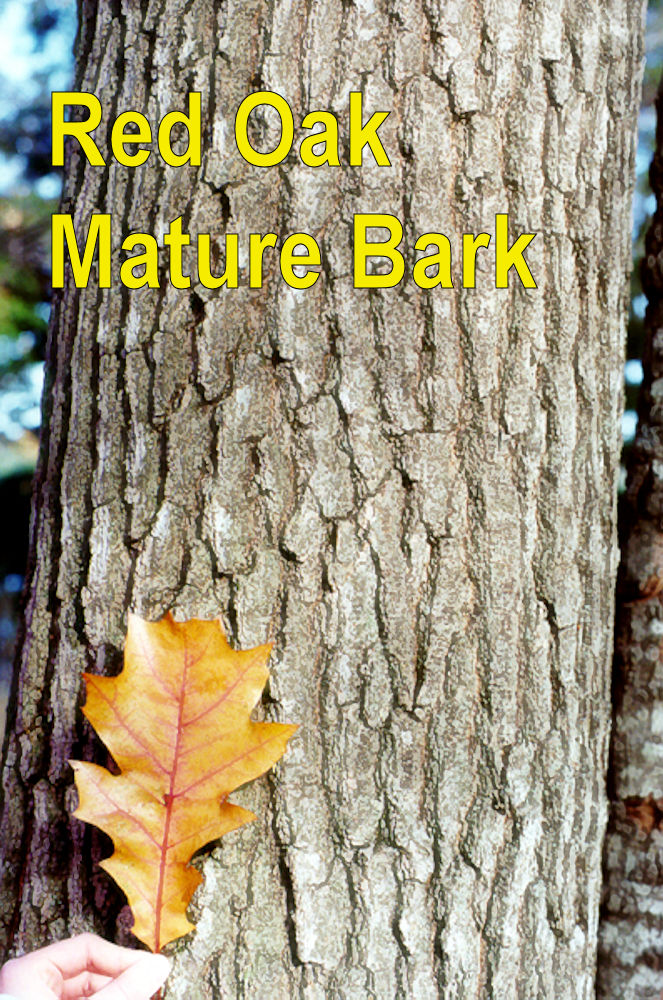

LEAVES of red oak are highly
variable in size and proportions of lobes
and sinuses. "Normally",
leaves are 5-9 inches long with 7-9 sharply pointed lobes.
Leaf sizes can come much smaller and much larger. Usually the mid-section of the
leaf is much broader than the lobes, yielding an appearance of being more leaf than
space. ACORNS are about 3/4 to 1 inch long with the acorn cup covering about 1/4 of
the acorn. Acorn shape varies. Terminal BUDS of red oak are usually in a cluster. TWIGS are steely gray and quite
stiff. BARK on young trees is also smooth and steely gray. As trees grow
larger, very firm plates and flattened ridges form. On preferred sites and properly
managed, red oak can grow magnificently formed, high-value TRUNKS. Red oak grows
best on rich, well-drained SOILS. Common ASSOCIATES include northern
hardwoods, pines, red maple, paper birch, and black cherry. Red oak is most common
in the central U.P. and the Keweenaw peninsula, although it can be found across the
region. It can be very difficult to tell the difference between poor quality red oak
and normal pin oak. Common pests: fall webworm, gypsy moth, leaf galls, loopers, cankerworms, orange-striped oakworm, skeletonizers, tussock moths, ugly nest caterpillar, walkingsticks, carpenter worm, red oak borer, two-lined chestnut borer, oak twig pruner, Anthracnose, oak wilt, Cylindrocladium root rot.
 NORTHERN PIN OAK
(Quercus ellipsoidales)
NORTHERN PIN OAK
(Quercus ellipsoidales)
Other
Names: Hill’s Oak, Scrub Oak, Jack Oak
Key ID Features: Leaves, Buds, Acorns, Stiff Twigs
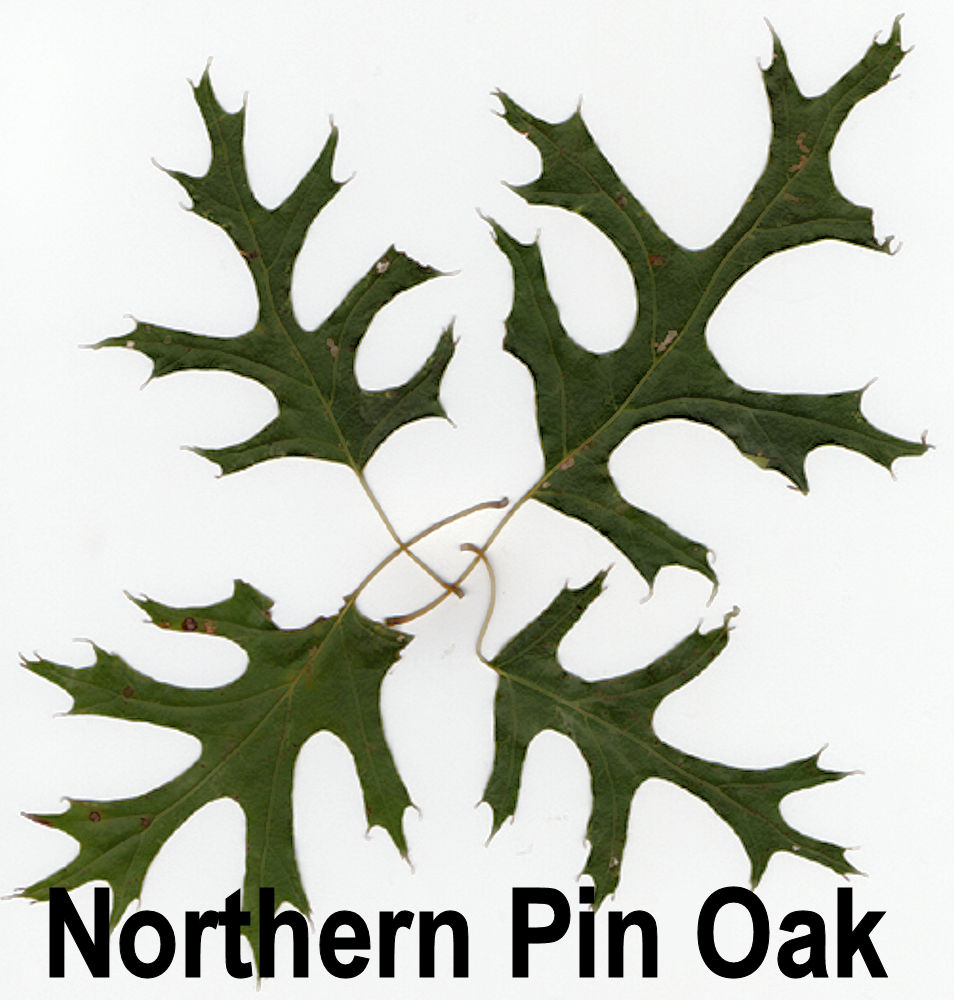
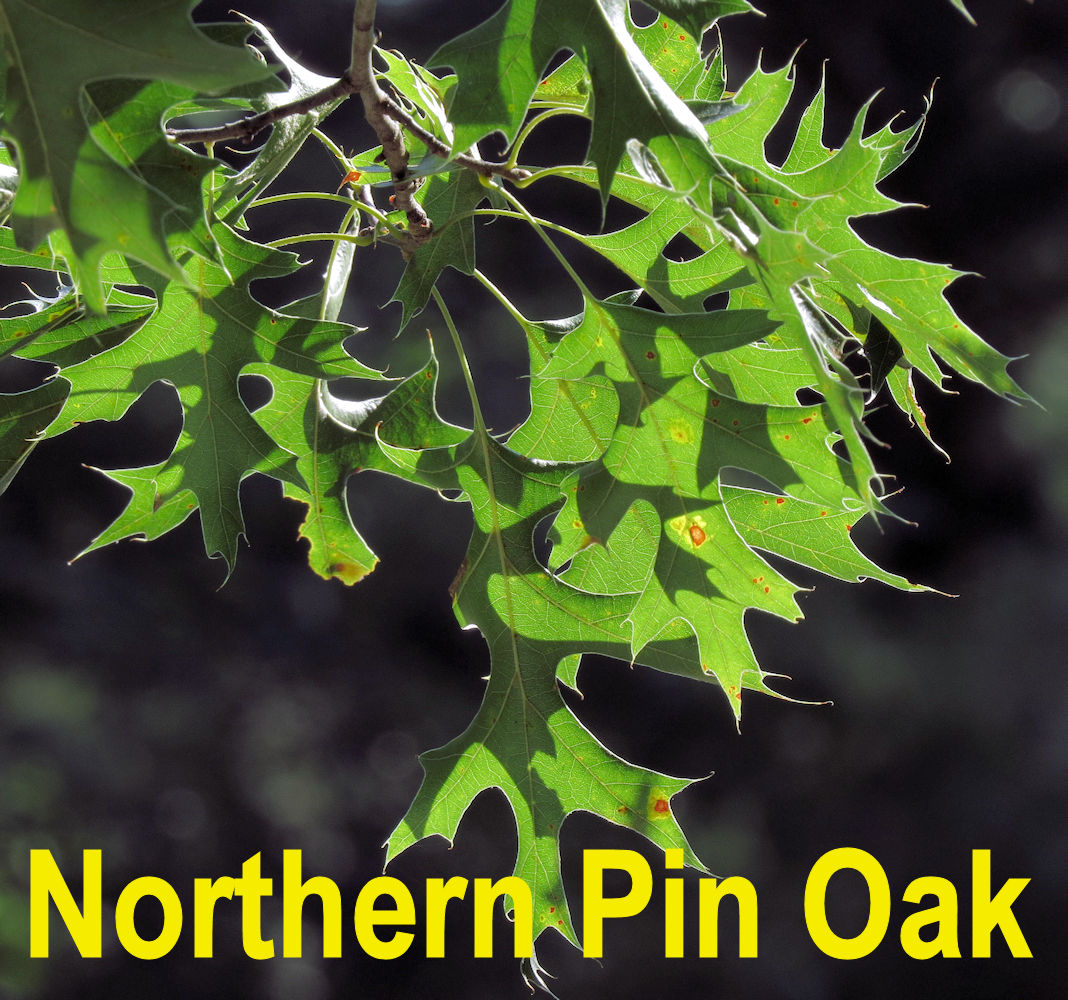

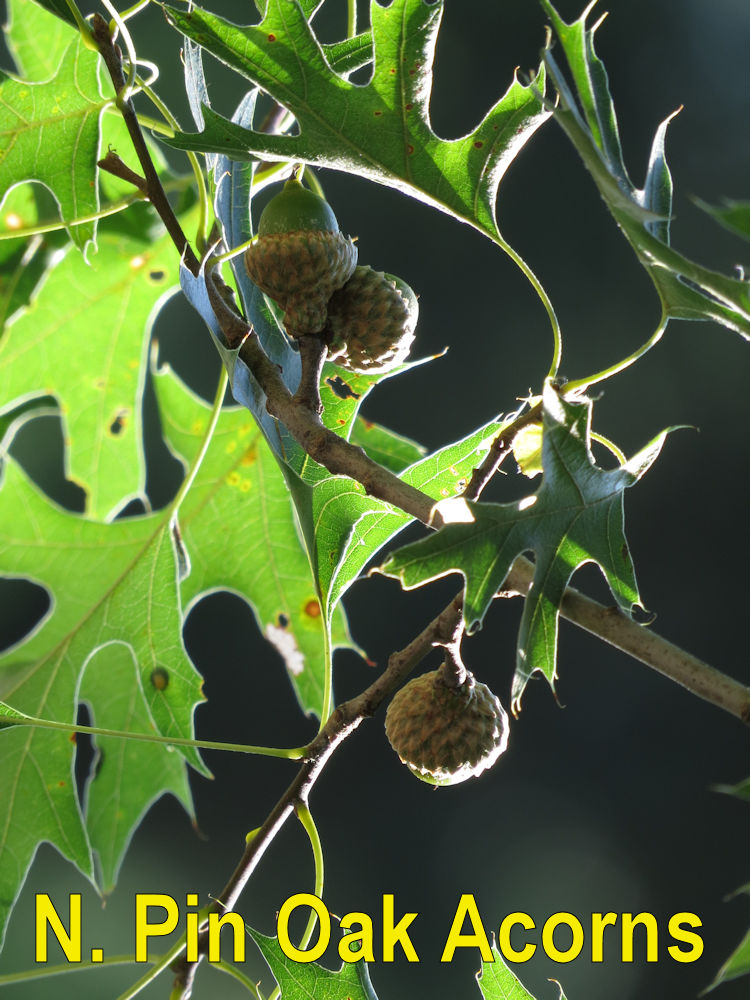
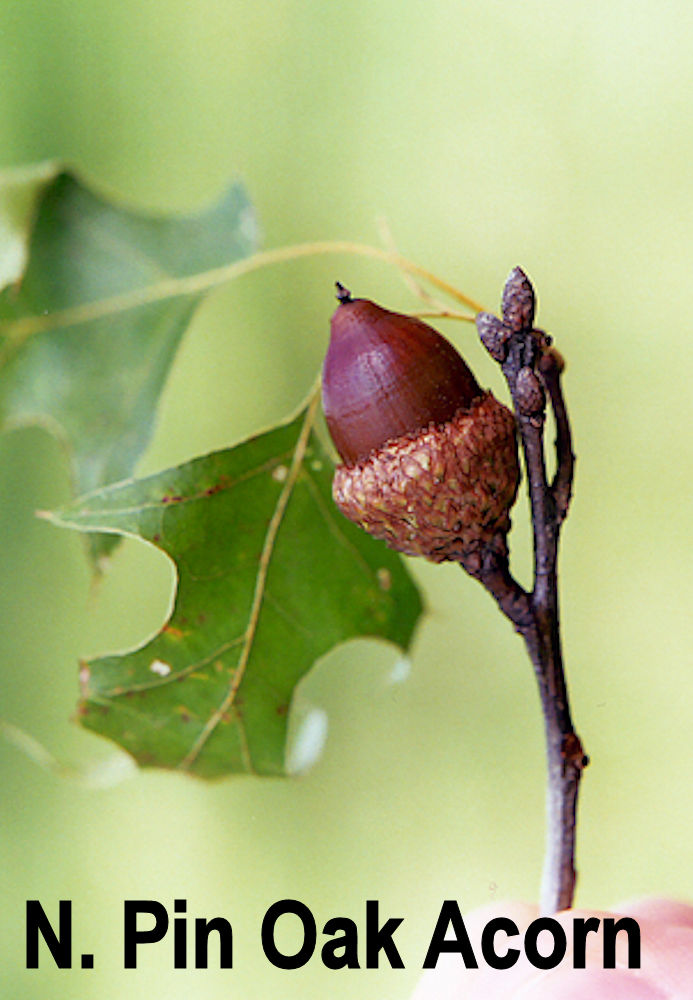
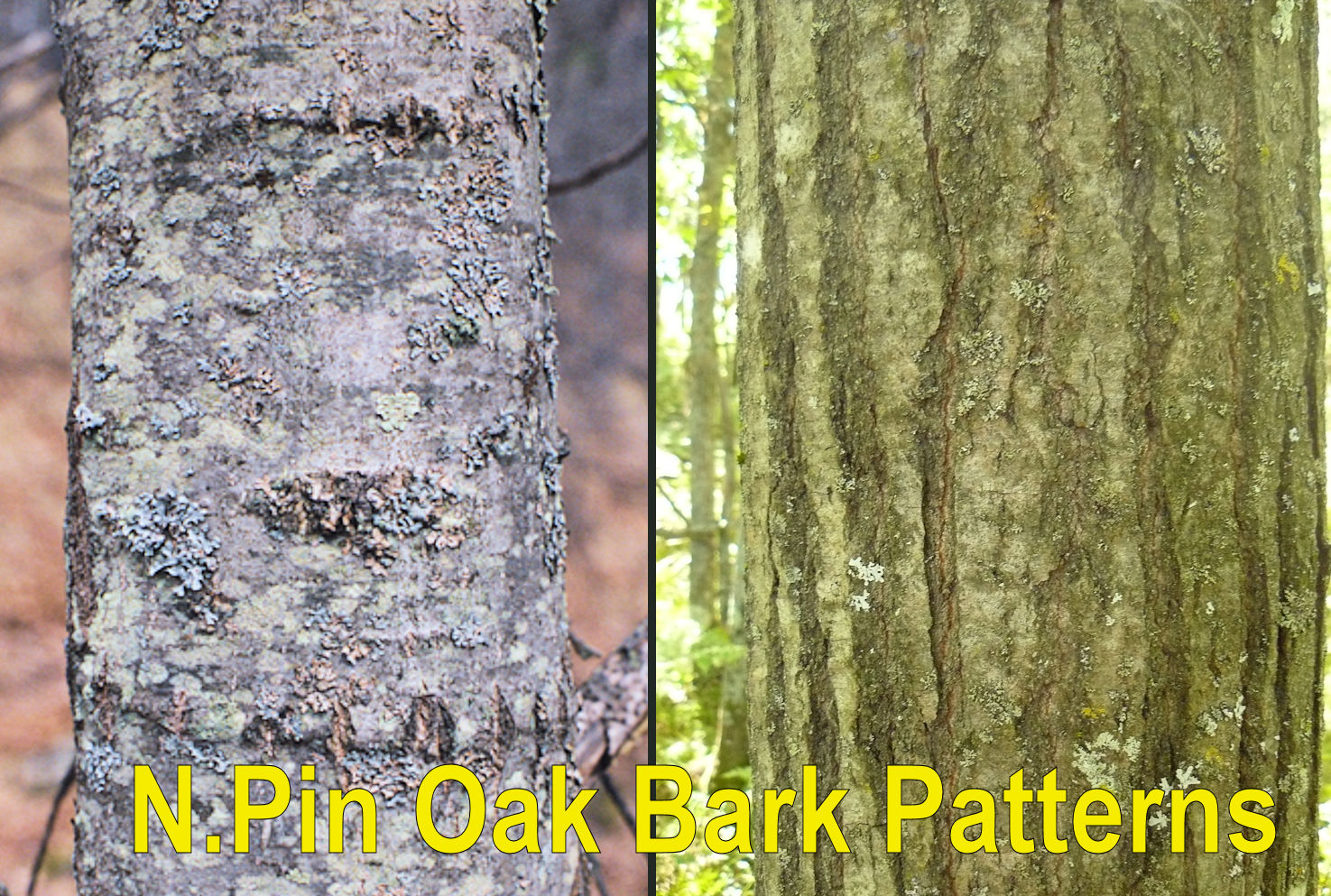
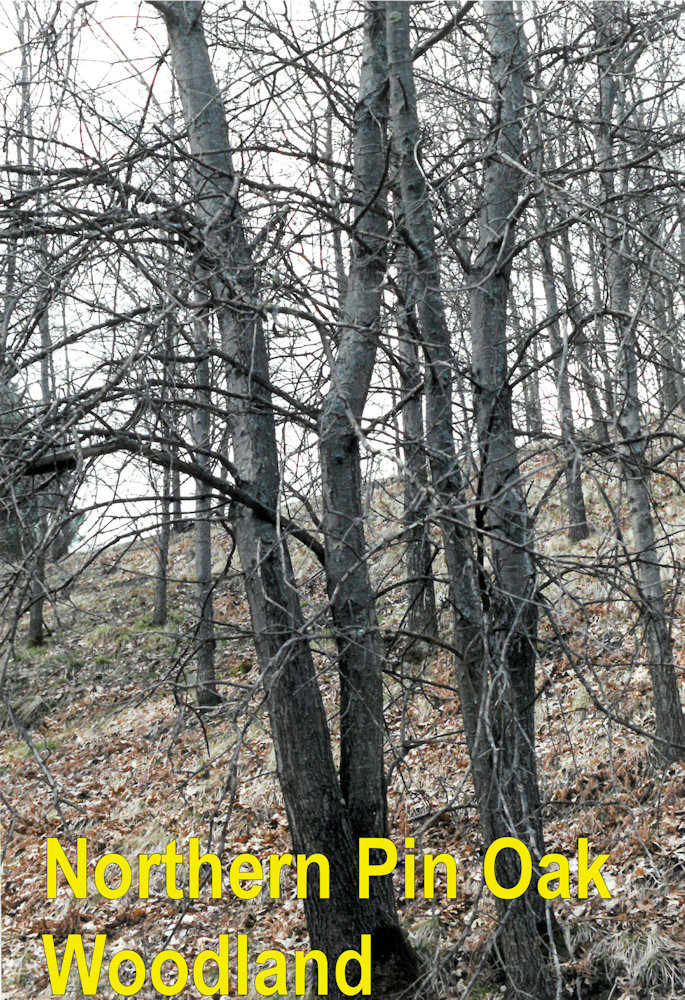
The LEAVES of
northern pin oak are 3-7 inches long and 5-7 lobes
with deep-cut sinuses and bristles
on the end of each lobe. The leaf appears to have more space than leaf surface. The ACORNS
are similar to red oak, but tend to be skinnier. The cup covers 1/3 to 1/2 the acorn. The
extremely stiff TWIGS are branchier with a random pattern. The SCRUBBY-LOOKING tree seldom
attains a size larger than 40-50 feet in HEIGHT and a foot in DIAMETER. The BARK is smooth
and gray on smaller trees and becomes rough and broken with age. The INNER BARK is
yellowish. Pin oak is often found on drier, sandier SITES in ASSOCIATION with jack pine,
paper birch, aspen, hazel, and other brush species. It commonly reproduces through stump sprouts, therefore often grows in
clumps. Incidentally, there is another pin oak (Quercus palustris)
that grows in the central hardwood region. It can be very difficult to tell the
difference between poor quality red oak and normal pin oak. Common pests: fall webworm, gypsy moth, leaf galls, loopers, cankerworms, orange-striped oakworm, skeletonizers, tussock moths, ugly nest caterpillar, walkingsticks, carpenter worm, red oak borer, two-lined chestnut borer, oak twig pruner, Anthracnose, oak wilt, Cylindrocladium root rot.
 BUR OAK
(Quercus macrocarpa)
BUR OAK
(Quercus macrocarpa)
Other
Names: Prairie Oak, Mossycup Oak, Scrub Oak, Blue Oak
Key ID Features: Leaves, Acorns, Corky Twigs, Buds
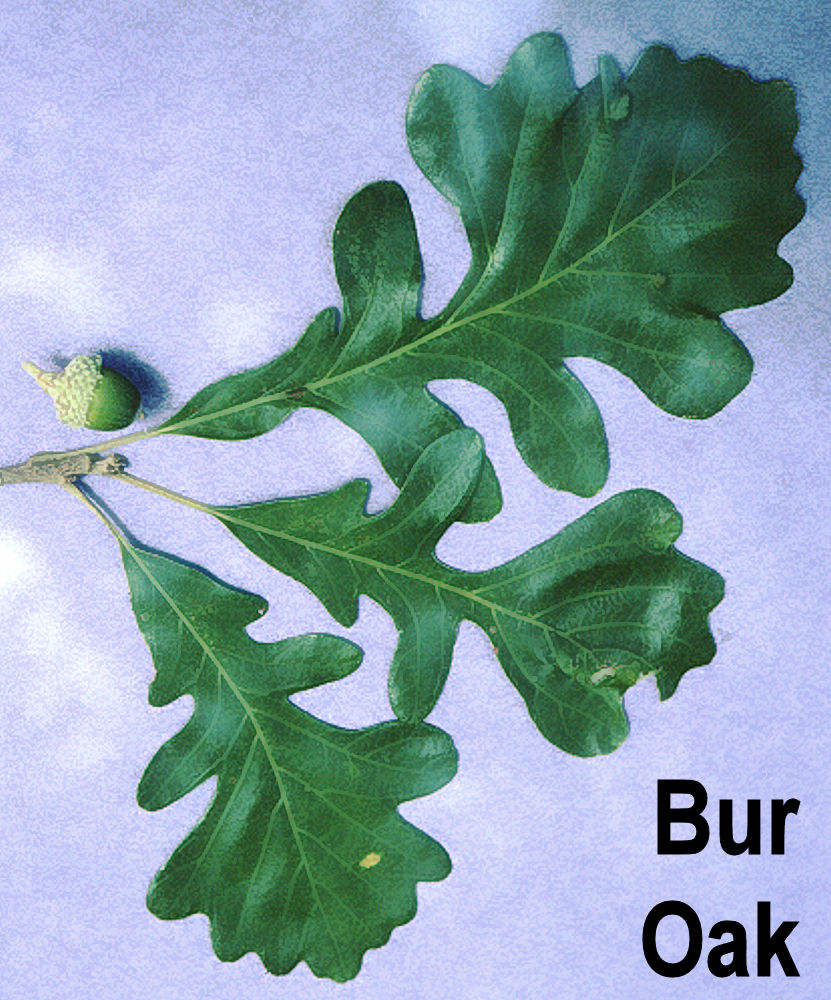
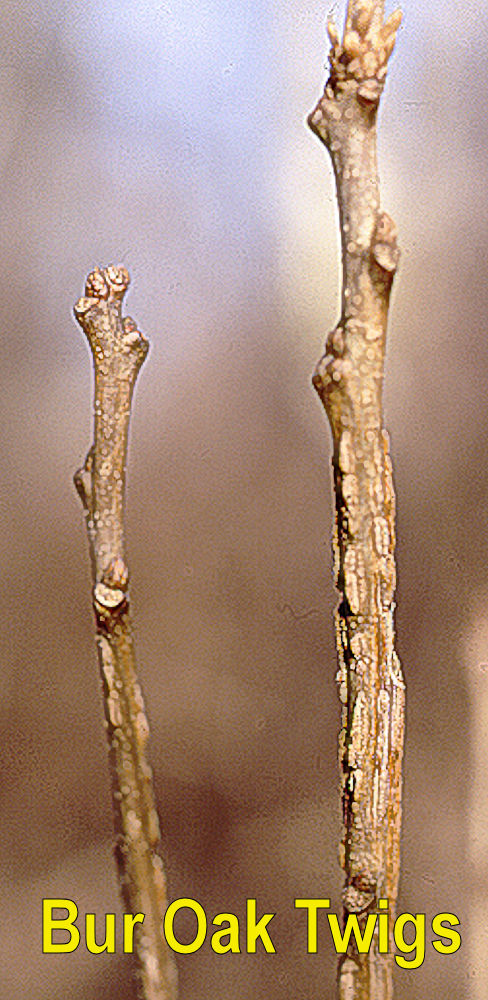
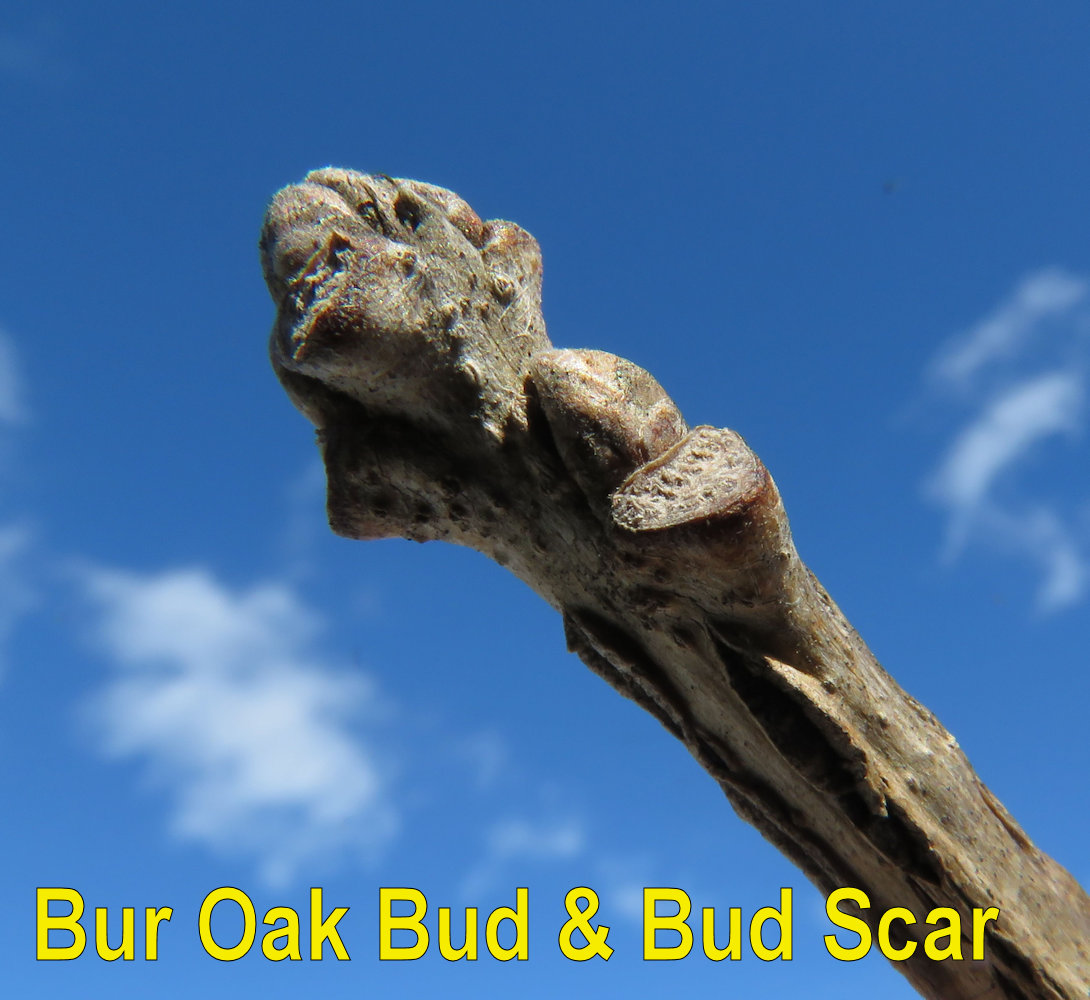
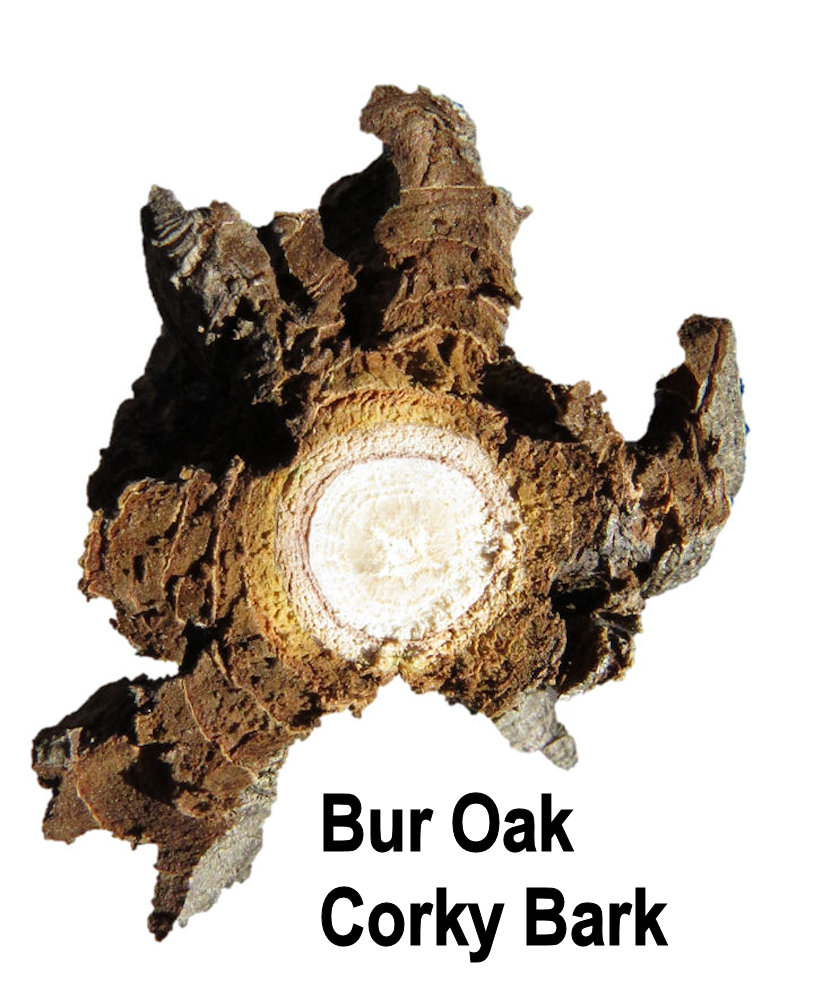
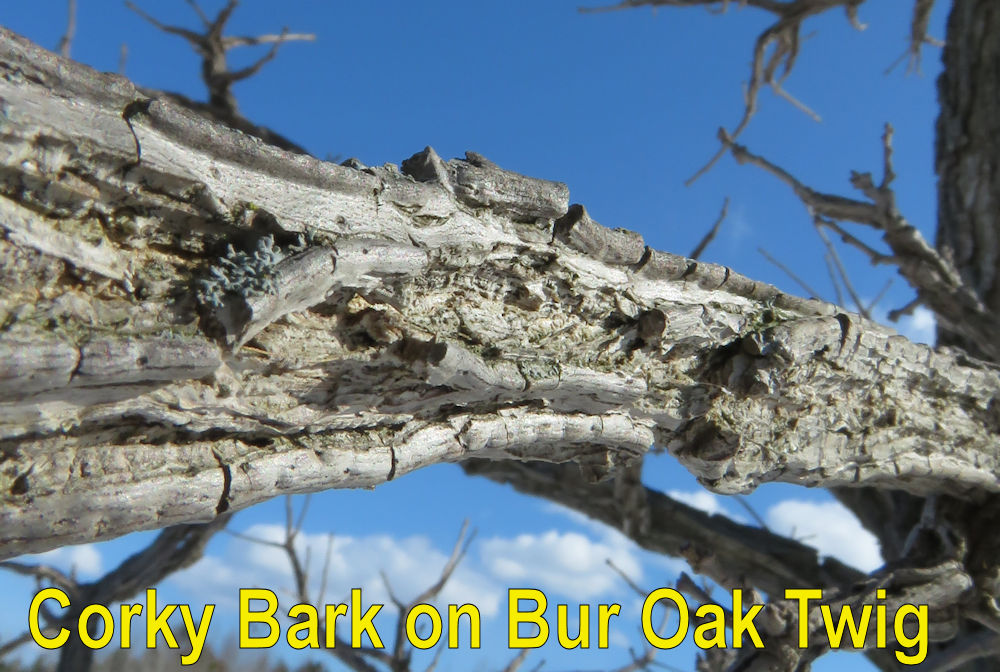
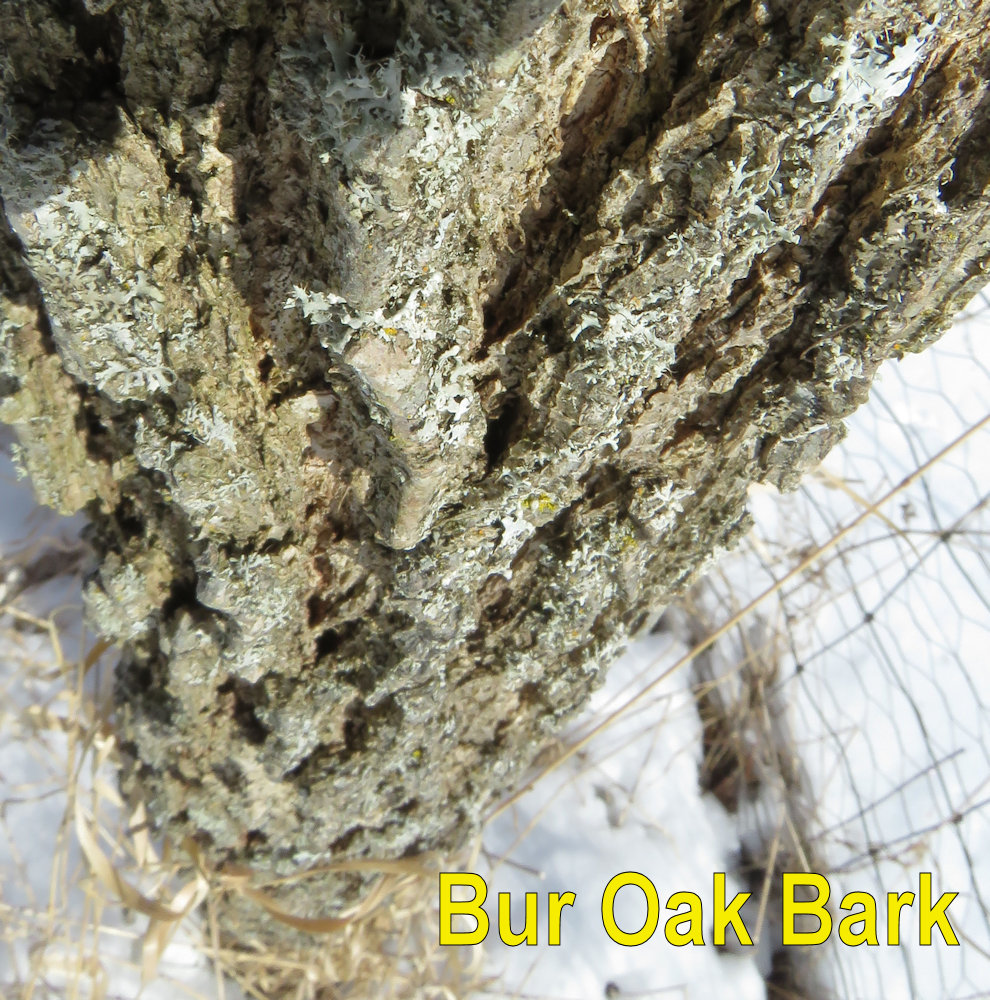
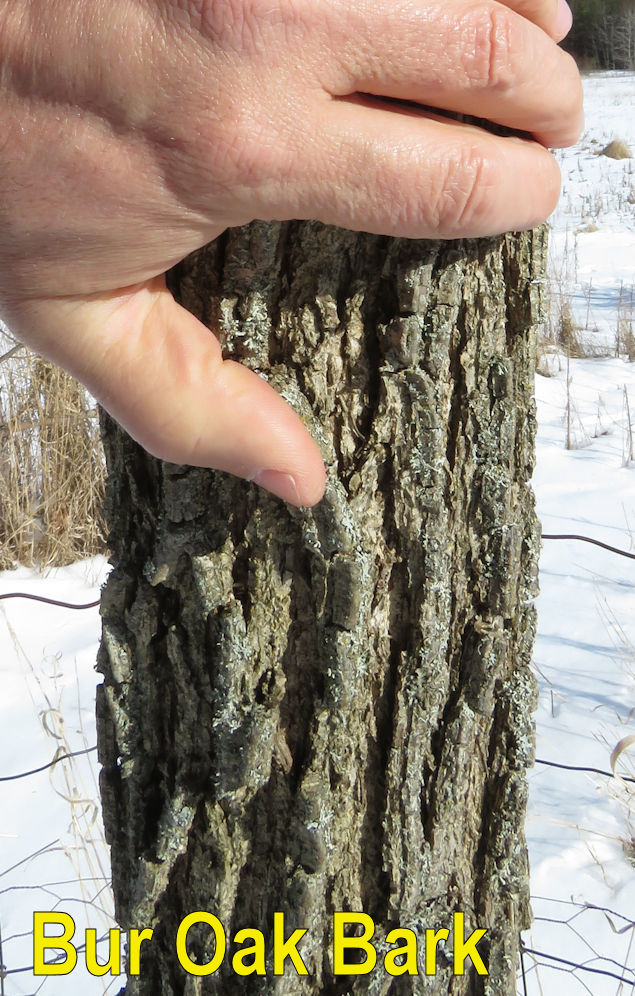
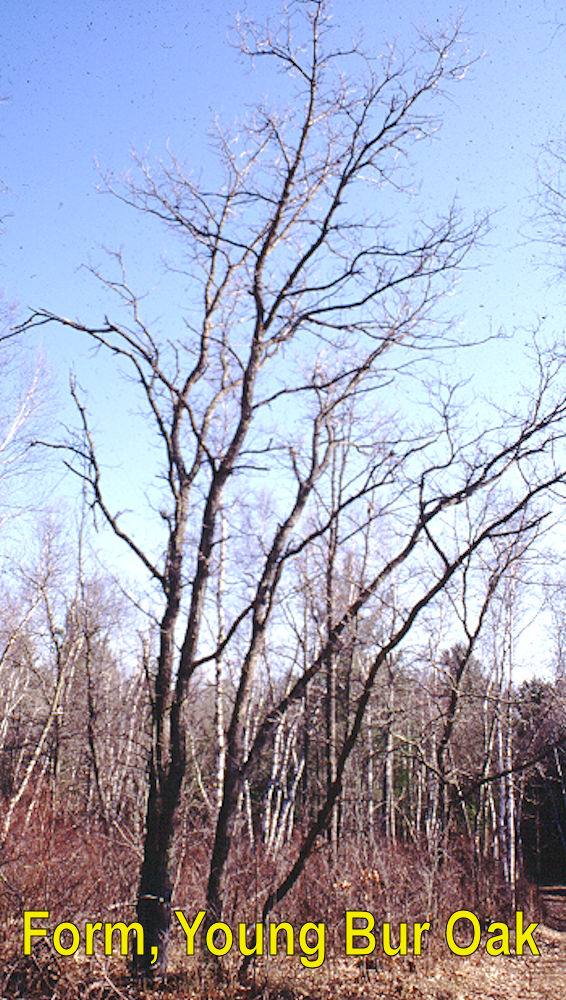
LEAVES of bur oak are
6-12 inches long with rounded lobes. Deep sinuses generally cut nearly to the mid-vein of most leaves. Knobby and shallow-sinused
lobes at the leaf end give the leaf a "club-shaped" appearance. ACORNS are
blunt, about an inch long, with a fuzzy cup covering nearly at least three-quarters of the
acorn. Acorns usually grow at the end of a short stalk. TWIGS are stout, often
with ridges or corky bark formations. Terminal BUDS are oval, sometimes with short hairs. The thick, medium-gray BARK allows the
tree to survive most ground fires, which is why bur oak is sometimes called prairie oak.
It was one of the few trees to survive the frequent prairie fires. Bur oak
prefers deep, rich, bottom-land SOILS, but will grow on just about any kind of soil from
dry gravel ridges to wetlands. The tree will grow to HEIGHTS of 50-60 feet and
DIAMETERS of over three feet, but often occurs in the U.P. as a SCRUBBY TREE in Menominee,
Gogebic, and Chippewa counties. It probably was not a component of the U.P. forest
until European settlement. Common pests: fall webworm, gypsy moth, leaf galls, loopers, cankerworms, orange-striped oakworm, skeletonizers, tussock moths, ugly nest caterpillar, walkingsticks, carpenter worm, red oak borer, two-lined chestnut borer, oak twig pruner, Anthracnose, oak wilt, Cylindrocladium root rot.
 WHITE OAK
(Quercus alba)
WHITE OAK
(Quercus alba)
Other
Names: Stave Oak, Barrel Oak
Key ID Features: Leaves, Buds, Acorns

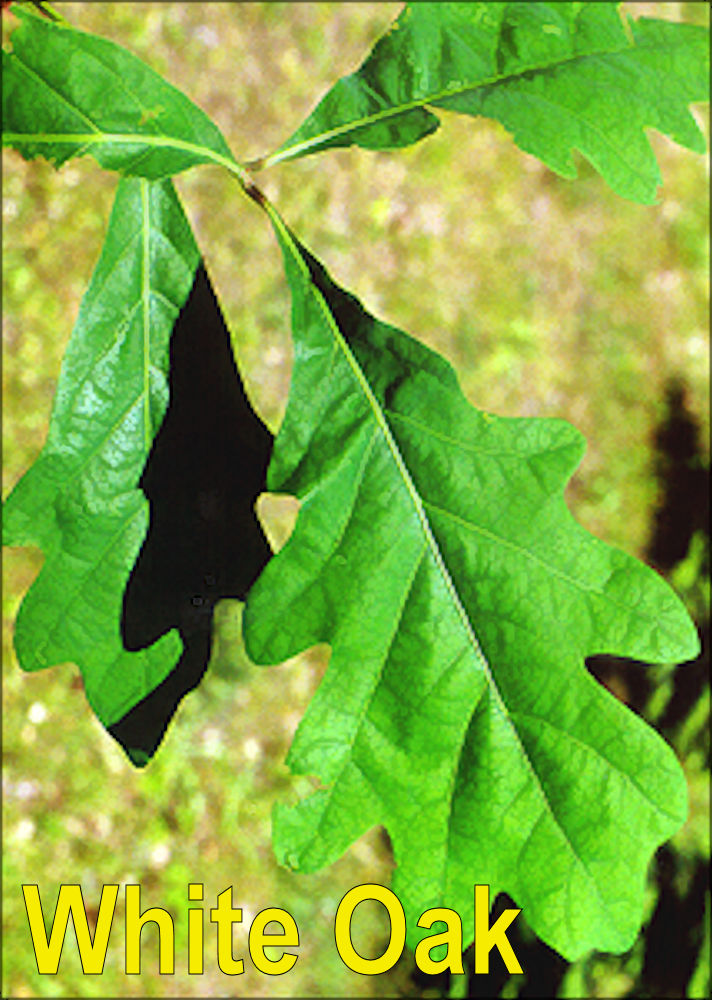

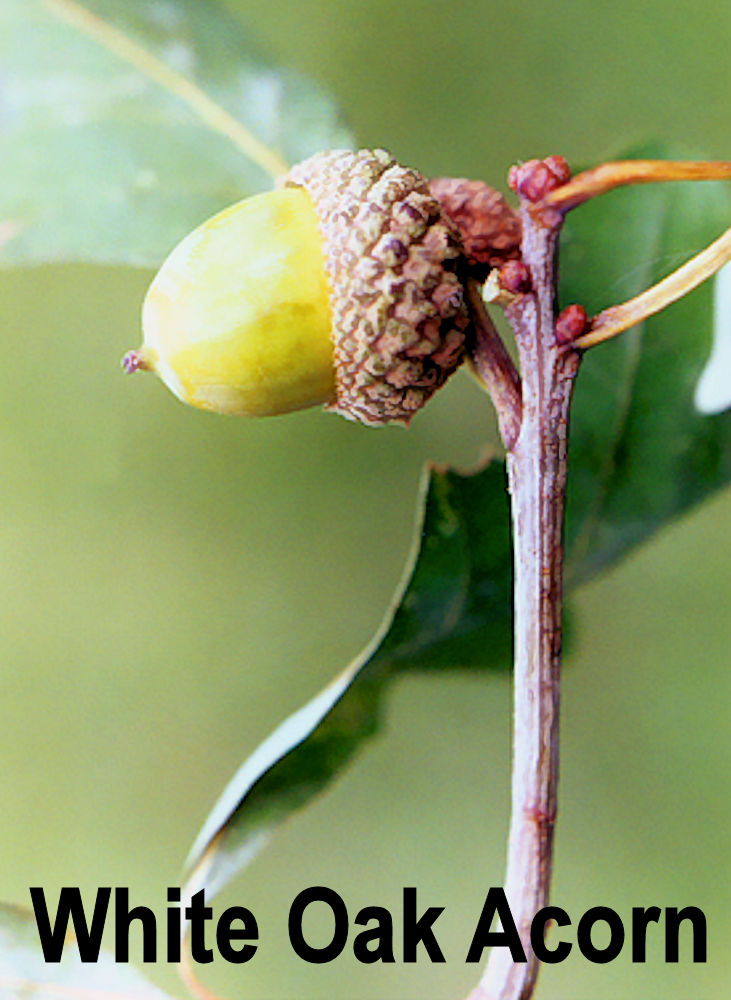


LEAVES are 5-9
inches long with 7-9 rounded, evenly-spaced lobes.
Sinus depth variable. ACORNS
are about 3/4 of a inch long with a cup enclosing about a 1/4 of the acorn.
Greenish-maroon-brown TWIGS have large clusters of roundish terminal BUDS. The BARK is light to medium
gray with shallow cracks and sometimes a little scaly. White oak is a component of
forests in southern Michigan and Wisconsin. It is quite RARE in the U.P. and most
likely occurs in the southern end of Menominee County or in some residential areas. Common pests: fall webworm, gypsy moth, leaf galls, loopers, cankerworms, orange-striped oakworm, skeletonizers, tussock moths, ugly nest caterpillar, walkingsticks, carpenter worm, red oak borer, two-lined chestnut borer, oak twig pruner, Anthracnose, oak wilt, Cylindrocladium root rot.
Click on the blue to return
to the Deciduous Summer Key or the Deciduous
Winter Key.
Click HERE to return to the home page.
A note about the images on this website, click here.
This site created and maintained by Bill Cook, MSU Extension Forester for the Upper Peninsula of Michigan. Editing and modification is ongoing. Submit suggestions, questions, and corrections to cookwi@msu.edu or call 906-786-1575.